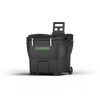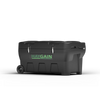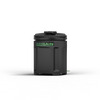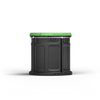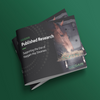Written by: Sharon Smith MSc SEBC(Reg.) IEng ACIWEM BSc(Hons) 
To rug, or not to rug? That is the question. Whether tis nobler in the mind to suffer the squall and torrents of midwinter blizzard, or to blanket against a brisk northerly and, by opposing, end them. With apologies to Shakespeare, every equestrian knows the drama of keeping a horse comfortable in autumn/winter. There are many articles about over-use of rugs on the internet, but people still do it. So now I’m literally going to get beneath the surface (of rugs!) using the latest research, to explain how horses keep themselves warm and the differences between us and them.
It starts with the fact that both people and horses generate their own body heat because we are both warm-blooded mammals. Yet, when people feel cold, our horses are perfectly comfortable because they have two extra features:
- a huge reservoir of active bacteria called the caecum – part of the digestive system
- a fur coat (or even a double-coat)
The Caecum
If we think of the body as a house, both humans and horses have a central heating system, but the horse’s caecum is like an extra-large wood-burner. The caecum is three times larger than the stomach, and sits on the right of the abdominal cavity, in between the small and large intestine. The horse naturally consumes and cultivates a vast population of bacteria from their food, and these bacteria can generate a lot of heat as they help the horse with digestion. Forage (specifically structural carbohydrate, such as cellulose in stems) generates the most heat.

Long-stem forage can be among the highest calorie, or the lowest calorie food for fat horses. Straw has half the calories of good hay and is clean and convenient to use. Nutritionists agree we can feed up to 30% of the ration as clean straw, alongside stemmy hay [1]. A Haygain steamer will soften stems to protect the stomach lining. Feed steamed forage while still warm in an effective slow feeder, like the Forager. This will ensure thorough chewing and a steady supply of fibre-fuel to the bacteria in the caecum.
Hay, of higher quality and quantity, is best for warming a thin horse that feels the cold. If a horse lacks appetite, obtain hay from a variety of sources, and steam it: for increased palatability; increased warmth, and to retain nutrients. Extra calories can be provided by the addition of oil to a forage-based bucket feed.
The coat
The horse’s fur coat stops body heat escaping, but doesn’t add heat – but neither do rugs. A healthy unclipped horse adjusts their own coat by fluffing-up to remain comfortable as conditions change through the day. This is an automatic response called piloerection. It uses the same little muscles that we call goose-bumps. Except, the horse has much denser, thicker hair, so more effective – especially if the rain-repelling natural oils in their coat are not removed by over-grooming. Some horses don’t grow much coat, or need to be clipped for their own benefit. But if you think a horse needs several rugs – think again. Using 3, 4 (even 5!) rugs restricts movement, increases pressure on the withers, and pushes out any trapped air rendering the bottom rug nearly useless! Use one, deep-bodied, clean, waterproof rug with a tail flap and neck-cover. If a thin horse still shivers, consult a vet. Horses prefer to shelter from wind before the rain, and finally cold [2]. A shelter can keep a horse more comfortable than rain-sheets and rugs, even when part-clipped. When the rain stops, the horse can shake themselves to dry their own coat very quickly. Haygain-steamed hay will protect respiratory health in stables and shelters.
Other natural mechanisms
In addition to the caecum and coat, three other related mechanisms help mammals be warm: body fat; metabolism and movement. Two types of body fat are of interest for warmth:
- white fat, which we associate with obesity. Excess ‘white fat’ only insulates the body from heat loss, just as ‘blubber’ does for seals. It does not generate heat.
- brown fat, or brown-like fat (aka ‘brite’ fat), that generates a lot of heat while actively mopping-up excess glucose sugar in blood plasma (owners of laminitics, take note!)
Active brown fat also releases a chemical that triggers the white fat to break down and replenish muscle energy stores, but only if the blood-sugar is low.
Different amounts of active fat may be one reason why some individuals become obese and others don’t. I say ‘individuals’, rather than ‘horses’, because some 20 years ago researchers failed to find true ‘brown fat’ deposits in new-born foals, and no-one seems to have looked for it since. However, the physical effects of metabolically active ‘brite’ fat have been widely observed in adult horses – even if not born with it. The mechanisms are there to make brite fat [3]. Also, stem cells are found in equine body fat. So perhaps these produce new, metabolically-active, blood-sugar-burning brite fat if the body needs it? The most recent research (in rodents and humans) also found white fat cells can turn into brite fat cells when the individual takes frequent, prolonged, aerobic exercise. For example, endurance trained rats burn 15% more calories at rest than identical sedentary rats [4].
Prolonged aerobic exercise is severely lacking in too many leisure horses these days. Arena schooling barely raises their heart rate. The horse’s lower leg conserves energy in trot and canter. Worse, is when owners erroneously believe a paddock layout of complex tracks provides enough aerobic exercise. Many horses have too low a metabolism from previous management practices and now they have access to too much food as well. The resulting obesity is blamed on the soil, ryegrass, lack of biodiversity, mineral imbalances… anything but the lack of exercise, it seems!

Turnout in cold weather is healthy in many other ways for fat horses and the metabolism ramps-up and burns more calories. Horses also burn calories in large muscles when they shiver; generating heat just like exercise. Their core body temperature won’t drop in only a few hours, if they have sufficient forage in the diet to keep the caecum active. So, it is positively healthy to avoid rugs and let fat horses shiver for a couple of hours a day. With ad-lib access to a shelter and an appropriate supply of steamed, low-calorie forage, even a part-clipped horse can stay un-rugged all winter, lose weight and still be comfortable.
References
[1] Harris, P. A., Ellis, A. D., Fradinho, M. J., Jansson, A., Julliand, V., Luthersson, N., ... & Vervuert, I. (2017). Feeding conserved forage to horses: recent advances and recommendations. animal, 11(6), 958-967.
[2] Hartmann, E., Hopkins, R. J., Blomgren, E., Ventorp, M., von Brömssen, C., & Dahlborn, K. (2015). Daytime shelter use of individually kept horses during Swedish summer. Journal of animal science, 93(2), 802-810.
[3] Braun, K., Oeckl, J., Westermeier, J., Li, Y., & Klingenspor, M. (2018). Non-adrenergic control of lipolysis and thermogenesis in adipose tissues. Journal of Experimental Biology, 221(Suppl 1), jeb165381.
[4] Sepa-Kishi, D. M., & Ceddia, R. B. (2016). Exercise-mediated effects on white and brown adipose tissue plasticity and metabolism. Exercise and sport sciences reviews, 44(1), 37-44.
